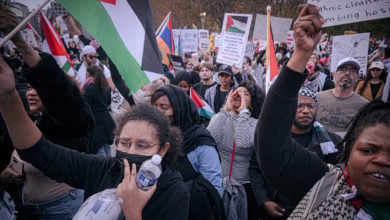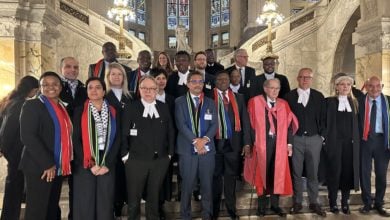On Dec. 31, hundreds of people protested at the U.S. Embassy in Baghdad, demanding an end to U.S. intervention in Iraq. As the protest went on for hours, dozens of the protesters managed to break into the main gate, go in, and set the main reception area on fire. Embassy officials frantically asked the Iraqi government for help. Shots were fired and several people were injured, but no deaths have, as of this writing, been reported in the incident.
By the evening, demonstrators had retreated from the compound, but continued their presence right outside and around the embassy. The demonstrators set up tents and declared the beginning of a sit-in, demanding that the U.S. pull its military forces out of Iraq.
U.S. bombs Iraq and Syria
The Embassy protest was the latest in a sequence of related recent events. On Friday, Dec. 27, there was a rocket attack on a military base in Kirkuk, in northern Iraq. The attack killed a U.S. contractor and injured four U.S. and two Iraqi military personnel. No groups or militias accepted responsibility for the attack. It was not factually established who carried out the attack. But the U.S. stated unequivocally that Iran was behind it. Specifically, the U.S. claimed that the attack had been carried out by Kataib Hezbollah, a militia that the U.S. simply calls an Iran proxy.
On Sunday, Dec. 29, the United States carried out air raids on several Kataib Hezbollah bases in western Iraq and eastern Syria, three in Iraq and two in Syria. The U.S. bombings reportedly killed 25 militants, including several commanders, and injured at least 55.
The U.S. bombings were met with widespread condemnation, including from Iraq’s government. On Monday, Dec. 30, Iraq’s caretaker Prime Minister Adel Abdul Mahdi strongly condemned the U.S. attack. A statement from Mahdi’s office reads: “The prime minister described the American attack on the Iraqi armed forces as an unacceptable vicious assault that will have dangerous consequences.”
The demonstrations at the U.S. Embassy were in protest to the U.S. bombings. However, more broadly, they are putting the spotlight back on the continued U.S. military presence in Iraq. Nearly 17 years after the U.S. invasion of Iraq in 2003, the U.S. continues to have upwards of 5,000 military forces, along with thousands of contractors, in Iraq.
Background to Shi’a militias in Iraq
It was not that long ago that the Islamic State controlled approximately one-third the area of Iraq and one-third the area of Syria. The meteoric rise of ISIS was the direct result of U.S. intervention in the Middle East. The U.S. had destroyed the sovereign government of Iraq through its 2003 invasion and its subsequent eight-year occupation — as mentioned above, U.S. troops remain in Iraq to this day. By supporting various reactionary rebels in Syria, including Al Qaeda, U.S. intervention had severely weakened the Syrian state.
ISIS had a modest military capability. Its strength was in launching terrorist attacks and bombings. It was not able to go toe to toe and hold territory against a competent military. But thanks to the severe weakness of the central governments in both Iraq and Syria, directly resulting from U.S. intervention, ISIS managed to gain control of a large territory against virtually no resistance.
ISIS controlling a huge contiguous territory in Syria and Iraq sent shock waves through the region. The Syrian government was already pushed to its limits, fighting against ISIS and various other terrorist groups lined up against it. The Iraqi state was weak. Its military, one formed and organized by the U.S. occupiers, had little capacity to fight. Faced with circumstances of serious combat, Iraqi forces were more likely to flee than to effectively fight ISIS.
People across Iraq started forming militias of volunteers to fight ISIS in both Iraq and Syria and take back the land it had taken. Kataib Hezbollah traces its history to this period, although many of its members had already been involved in fighting the U.S. occupying force in the previous era. Kataib Hezbollah is now part of a coalition of Shi’a militias called Popular Mobilization Forces. The founder of Kataib Hezbollah, now a senior PMF commander, Jamal Jaafar Ibrahimi, vowed revenge: “Our response will be very tough on the American forces in Iraq.”
After ISIS was defeated, over time, various militias that had actively fought ISIS were gradually incorporated into Iraq’s military, as happened to Kataib Hezbollah in July 2019. This why the Iraqi government condemned the U.S. bombing as an attack on “Iraqi armed forces.” In fact, the U.S. bombed the Iraqi military, not just an unaffiliated militia that is running out of control.
Iraq’s government
Due to its unique history, Iraq’s government is an entirely contradictory entity. On the one hand, it is a government that traces its roots to the system of government the U.S. occupiers set up. On the other hand, due to the tremendous resolve and perseverance of Iraqi resistance to the U.S. occupation, the U.S. was forced to completely abandon its dream of setting up a puppet client in Iraq. The government is, therefore, a force that has been doing a balancing act since its inception.
Various Iraqi administrations since have taken a conciliatory line towards the United States, while also maintaining close ties with Iran, Iraq’s neighbor, an influential regional force and diametrically opposed to U.S. imperialism in the region. When ISIS took over Kirkuk and a large region in Iraq and Syria, the Iraqi government asked for and welcomed direct U.S. military assistance. However, it also asked for Iran’s help and welcomed its involvement in organizing, arming and training militias to fight ISIS.
Prime Minister Mahdi is now heading a caretaker government that is the product of a concession the government had to make in response to months of large and ongoing protests, against which government repression and violence has been used.
The attack on the U.S. Embassy and the planned sit-in puts Mahdi’s government in a difficult position. The U.S. bombing of a militia that is a part of the country’s armed forces is such a blatant violation of Iraqi sovereignty that Mahdi has already had to condemn it. But mass outrage might force Mahdi and/or Iraq’s lawmakers to go further and demand that the U.S. military leave Iraq altogether. On the night of the protests at the Embassy, the U.S. military flew Apache helicopters overhead and dropped flares over the area, in what it called a “show of force.” Imperialist arrogance prevents Washington policymakers from understanding how this kind of show of force within Iraqi soil enrages the masses and makes it more difficult for the Iraqi government to justify continued U.S. military presence in their country.
Another potential impact of the U.S. bombings may be on the ongoing protest movement. Some individuals interviewed at Tahrir Square, the site of months-long protests against government corruption, made it clear that they were different from the demonstrators at the U.S. Embassy. The protests at the U.S. Embassy are likely to continue for some time and possibly result in a widespread mass demand for the U.S. military to leave Iraq. This could impact the size of the anti-government protests, or it may impact their political character and alter their central political demands.
Regionally, it is possible for the current developments to lead in an escalation of tensions between the U.S. and Iran. On Dec. 31, President Trump stated that Iran would be held “fully responsible” for the attack on the U.S. Embassy in Baghdad. He also tweeted the following: “They will pay a very BIG PRICE! This is not a Warning, it is a Threat. Happy New Year!”
Of course, the bellicose tone of Trump’s tweets give rise to fears of another U.S. military aggression in the region. However, there are several reason that this may not happen. For one thing, the justification for an escalation at this time is quite thin. U.S. pretexts for military aggression have often been justifications based on obvious concoctions — for example, Iraq’s alleged possession of weapons of mass destruction in 2003. Still, militarily attacking Iran over the protest of Iraqis at the U.S. Embassy in Baghdad would be a new reach.
Over his first three years as president, Trump has unilaterally and illegally pulled the U.S. out of the JCPOA agreement with Iran and implemented a policy of “maximum pressure.” But Trump has also resisted relentless pressure by his advisers to directly attack Iran militarily.
Recent developments in Iraq represent the possibility of a further deepening of anti-imperialist movements in the Middle East, as well as the possibility of further U.S. acts of aggression in the region.






